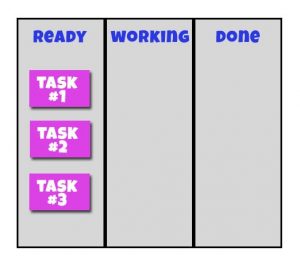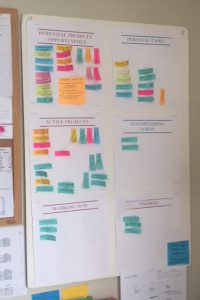Hi, it’s Rachael Kraft. Today, I’d like to help you with a simple system to help your business stay more organized and be more productive on a daily basis.
To get started, think of your dog…
Now, if you were to grab a single doggy bone and toss it to your pup, he’d scarf it down in no time flat.
But, if you reach down deep into the bag of treats and bring out an entire handful of goodies – well, your dog might not fare so well…
Chances are, he’ll look around in panic and not manage to catch a single morsel.

How Can a Dog Metaphor Help Your Business?
Well, when it comes to business, a lot of people I see are creating extremely long “to-do” lists to keep track of project milestones and tasks.
They don’t have a clear system to organize tasks by overarching project or to keep track of high-priority items.
Often, lower priority tasks get overlooked day after day – and weeks or months may pass with no real progress.
Just like a dog trying to catch too many treats at once, you and your team become overwhelmed with your to-do list and productivity decreases.
Two Guiding Principles to Rule Them All
To solve this problem, I recommend the Personal Kanban system developed by Japanese scientists working in the auto industry.
This topic was brought to our American audience by Jim Benson and Tonianne DeMaria Barry in their book Personal Kanban: Mapping Work, Navigating Life.
A Personal Kanban board works under two main principles: 1) visualize your work and 2) limit your work-in-progress (WIP).
By focusing on a more limited number of tasks at any given time, you are able to increase your focus and achieve more productivity.
It allows you to clearly see your tasks, actively reorganize your work flow, and better prioritize steps to produce better final results.
Since you are limiting your WIP, you’ll be able to lower your stress levels and complete tasks more efficiently.
How to Build Your Own Personal Kanban
To get started using this technique in your own business, start with a very basic Kanban chart divided into three columns.
Label these columns: READY, WORKING, and DONE.

Then, list out every single task you can think of for any given period of time or project.
Choose ten of the most important items and stick them to the board on the READY column. Each item should be written on a moveable piece of paper like an index card or sticky note.
Now, this Kanban works well with a white board and sticky notes. Other people will prefer a corkboard with pins. You could even create a travel-sized Kanban using a foldable folder, magnets, or any other system you can dream up.
The important thing is that you can physically move tasks through the columns as you complete your work.
Remember our friend the dog?
He taught us that we can only handle a limited number of tasks at once.
So, pull just two or three tasks from your READY column into your WORKING column.
Now, focus on those tasks 100% and get them done. Do rock-star level work and block out any concerns or ideas that don’t pertain to your WORKING tasks.
Once you have finished a task, take the time to physically move that item from your WORKING column into your DONE column. This will give you a satisfying visual sense of what you’ve accomplished come the end of each working day.
Once those initial two or three tasks are complete, pull more items from your READY column and watch it shrink with each passing hour. Eventually, you may pull more tasks from your backlog into the READY column.
Adapt Your Kanban to Match Your Personal Business & Style
The Kanban system is glorious largely because it can be very flexible. Use it however you like!
You can arrange the READY tasks in any way you want. Group tasks by bigger project, color code them or tilt them side-ways when you’re waiting on a needed item.
Create individual Kanbans for each larger project, or group everything into one giant monster board.
It’s completely up to you.
This visual reorganization process will help you keep track of items and better map out a path for success.
You can also customize the number of columns you have on your board. My own Kanban currently has six columns and includes a section for “prospects” and an additional column for “personal tasks and goals”.

Occasionally, you should take some time to reflect when looking at your board. Could you handle more WIP tasks at once? Or, is three tasks too much and maybe you should limit to one or two?
Does the value stream of three columns work for you? Maybe you need to have many more columns?
For instance, a writer might have six columns labeled like this: Backlog > Writing > In Review > Revision > Final Review > Final Draft > Complete.
There are no hard and fast rules for your own Personal Kanban. Just remember to visualize your work and limit your work in progress. Your business tasks will get done faster and with higher quality using this handy system.
If you’d like to learn more about how I help small businesses organize their marketing systems, drop me a line at rkraft@kraftedonline.com.







Leave a Comment
You must be logged in to post a comment.